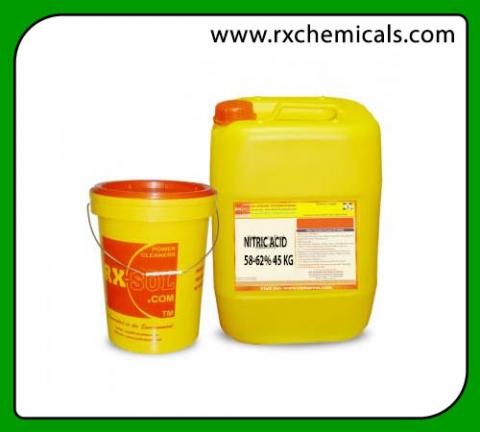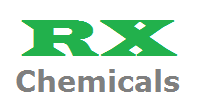
NITRIC ACID 58-62% 45 KG
| Chemica Name | CAS # | % by weight | NITRIC ACID | 7697-37-2 | 62.0- 68. | WATER | 7732-18-5 | 38.0- 32.0 |

| Eye |
Can cause permanent eye injury. Symptoms include stinging, tearing, redness, and swelling of eyes. Can injure the cornea and cause blindness. |
| Skin |
Can cause permanent skin damage. Symptoms may include redness, burning, and swelling of skin, burns, and other skin damage |
| Swallowing |
Swallowing this material may be harmful or fatal. Symptoms may include severe stomach and intestinal irritation (nausea, vomiting, diarrhea), abdominal pain, and vomiting of blood. Swallowing this material may cause burns and destroy tissue in the mouth, throat, and digestive tract. Low blood pressure and shock may occur as a result of severe tissue injury. |
| Inhalation |
It is possible to breathe this material under certain conditions of handling and use (for example, during heating, spraying, or stirring). Breathing this material may be harmful or fatal. Symptoms may include severe irritation and burns to the nose, throat, and respiratory tract. |
| Symptoms of Exposure | No Data |
| Target Organ Effects | No Data |
| Developmental Information | No Data |
| Cancer Information | No Data |
| Other Health Effects | No Data |
Primary Route(s) of Entry
Inhalation, Skin contact, Eye contact
What is passivation?
The "passivation" process removes iron residues and probably forms an oxide layer that boosts the corrosion resistance of the stainless steel.
According to ASTM A380, passivation is "the removal of exogenous iron or iron compounds from the surface of stainless steel by means of a chemical dissolution, most typically by a treatment with an acid solution that will remove the surface contamination, but will not significantly affect the stainless steel itself." In addition, it also describes passivation as "the chemical treatment of stainless steel with a mild oxidant, such as a nitric acid solution, for the purpose of enhancing the spontaneous formation of the protective passive film."
In lay terms, the passivation process removes "free iron" contamination left behind on the surface of the stainless steel from machining and fabricating. These contaminants are potential corrosion sites that result in premature corrosion and ultimately result in deterioration of the component if not removed. In addition, the passivation process facilitates the formation of a thin, transparent oxide film that protects the stainless steel from selective oxidation (corrosion). So what is passivation? Is it cleaning? Is it a protective coating? It is a combination of both.
GENERAL PASSIVATION METHOD
To effectively passivate the free-machining stainless steels, Carpenter has developed the A-A-A (alkaline-acid-alkaline) process that neutralizes trapped acid. This method of passivation can be accomplished in less than 2 hours. Here is the step-by-step procedure:
After degreasing, soak the parts for 30 minutes in a 5 percent solution of sodium hydroxide at 160[degrees]F to 180[degrees]F (71[degrees]C to 82[degrees]C). Then rinse the part thoroughly in water. Next, immerse the part for 30 minutes in a 20 percent-by-volume nitric acid solution containing 3 ounces per gallon (22 g/liter) of sodium dichromate at 120[degrees]F to 140[degrees]F (49[degrees]C to 60[degrees]C). After removing the part from this bath, flush it with water, then immerse it in the sodium hydroxide solution for another 30 minutes. Rinse the part again with water and dry it, completing the A-A-A method. The benefits of this method are shown in Figure 3.
OR
As per ASTM standards For Type 304 stainless steel :::: FIRST OF ALL degrease the parts and then wash them in an alkaline bath for 10 minutes. After 10 minutes the parts are rinsed in clean water before being immersed in a Nitric 2 solution. 20 to 45 volume percent of nitric acid. The parts are then immersed for 30 minutes at a temperature range of 70 to 90 degrees F. They are then rinsed in water left to air dry.
PRECAUTION : 1 > DO avoid chlorides that, in excess, can cause a harmful flash attack. When possible, use only a good grade of water containing less than about 50 parts per million (ppm) of chlorides. Tap water is usually adequate, and in some cases up In several hundred ppm chlorides can be tolerated. 2> Loose iron particles or other foreign particles must be removed or they will appear as rust or stain spots. may become smeared over or imbedded into the surface of corrosion-resistant steel parts.
CITRIC ACID passivation process:
Citric acid passivation has become increasingly popular with manufacturers who want to avoid the use of mineral acids or solutions containing sodium dichromate, along with the disposal problems and greater safety concerns associated with their use. Citric acid is considered environmentally friendly in every respect.
Although citric acid passivation offers attractive environmental advantages, shops having success with mineral acid passivation and suffering no safety issues might want to stay the course. There may be no real need to change if those users have a clean shop, well-maintained and clean equipment, coolant tree of iron-containing shop dirt, and a process that yields good results.
WHY SODIUM DICHROMATE ??
After thorough cleaning, the stainless steel part is ready for immersion in a passivating acid bath. Any one of three approaches can be used--nitric acid passivation, nitric acid with sodium dichromate passivation and citric acid passivation. Which approach to use depends on the grade of stainless steel and prescribed acceptance criteria.
More resistant chromium-nickel grades can be passivated in a 20 percent-by-volume nitric acid bath (Figure 2). As indicated in the same table, less resistant stainless grades can be passivated by adding sodium dichromate to the nitric acid bath to make the solution more oxidizing and capable of forming a passive film on the surface. Another option, used in place of nitric acid plus sodium dichromate, is to increase the concentration of nitric acid to 50 percent-by-volume The sodium dichromate addition and lit : higher nitric acid concentration both reduce the chance of undesirable flash attack.
TEST METHOD for PASSIVATION
Can anyone suggest a simple and quick test which can distinguish between a piece of nitric acid passivated 420 stainless steel and a non-passivated one?
ANSWER : 1 . there is no known simple method to distinguish between a piece of nitric acid passivated 420 stainless steel and a non-passivated one.
ANSWER : 2. Because of the way nitric acid passivation works there is no easy way to test whether it's been done or not. Nitric acid simply dissolves the oxides from the surface and forms a near complete layer of oxide, which protects the underlying metal from further oxidation. Since no chemical is deposited, and it's a relatively weak method of passivation, it would be very hard to test. You can compare panels before and after in a corrosion chamber to see the results, but I'm not sure you could test individual panels and determine whether they had been passivated conclusively.
ANSWER : 3. It was my understanding that you could easily check the passivation status of a part using a solution of copper sulfate and dilute sulfuric acid. An unpassivated part will show copper immersion.
The simple tests for passivation are the acidified copper sulfate test (referred to above) and a ferric cyanide test - both specfified in ASTM ASTM A380 [link is to spec at TechStreet]. These tests are primarily checking for free iron on the surface and cannot confirm that nitric acid passivation has specfically been performed.
How does copper sulfate test for passivation work?
I have heard that a way to check for iron on the surface of a passivated stainless steel part is with the copper sulfate test. From what I can gather the copper replaces the iron due to the fact that the iron is more easily oxidized. Chromium is more easily oxidized than iron, so why doesn't the copper also replace the chromium?
ANSWER : Chromium and nickel will not be replaced with the Copper sulfate test solution (which also contains sulfuric acid), only the Fe or other less noble metals. If there is free iron on the surface it will be replaced by the copper, forming the distinctive copper color on the surface in this 6 minute test.
Of course, this test should only be used on austenitic stainless steel. Some people use it on other grades, but you can get false failures.
How do you separate iron from stainless steel?
Hydrochloric acid. It'll bubble on contact with iron, and eventually dissolve it, allowing you to identify which is which or simply remove the iron. "Stainless Steel" is steel in which most or all of the carbon has been removed.
NITRIC ACID manufacturer supplier distributor in Mumbai, Kandla, Kolkata, Vizag, Chennai, India, Fujairah, Dubai UAE, Muscat Oman, Kenya Africa. Get the best quality of NITRIC ACID at a competitive price from us. We have ready stock of NITRIC ACID in India, UAE Gulf, Oman, Kenya Africa. Contact us for bulk as well as small orders.




